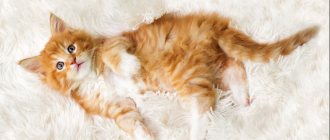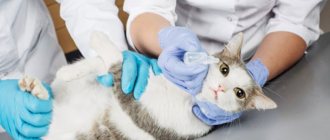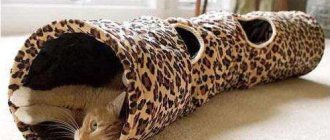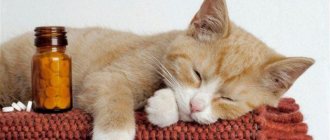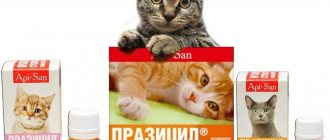5010Pavel
If you have a pet four-legged friend - a cat or a dog, you must be prepared for different life situations. After all, problems often arise when a pet is sick, a veterinarian prescribes subcutaneous drips for a cat, and the owner of a mustachioed cat does not have the opportunity to take the animal to a specialist for chronic kidney disease every time. What to do, don’t leave your pet to the mercy of fate.
Let's try to figure out how to properly place IVs on a cat, and in what situations they are prescribed.
© shutterstock
What is a subcutaneous drip
In veterinary medicine, a drip is called infusion therapy. A special system is used to administer the drug in solution form.
It consists of the following parts:
- a needle for taking medicine from a bottle;
- storage tank;
- long PVC tube;
- roller clamp to regulate the speed of solution infusion;
- needle for insertion into a vein.
If the animal is facing a long course of treatment, then installing a catheter for the cat at home will eliminate the need to insert a needle into a vein every day. Then the pet will not experience pain during the procedure.
Indications for subcutaneous infusion
A cat drip is prescribed to cleanse the body of harmful substances or for viral infections. If you need to quickly replenish your supply of vitamins, your veterinarian may prescribe intravenous injections.
Subcutaneous drips for cats are indicated in the following cases:
- in case of poisoning;
- for dehydration, which may be caused by prolonged vomiting or diarrhea;
- with renal failure;
- to eliminate vitamin deficiency;
- as maintenance therapy for complex treatment.
You cannot choose medications for injections and drips on your own. Both an adult animal and a kitten should only be prescribed treatment by a veterinarian.
Important! There are drugs that cannot be injected under the skin or into a muscle; they can only be injected into a vein.
Preparation
The process of placing an IV in a cat is quite simple and painless if done correctly . Therefore, the main point here is to get rid of your own fear. The animal will easily feel your excitement, and the procedure will be significantly delayed.
Owners who are encountering a dropper device for the first time need to study it thoroughly before using it. This makes it easier to avoid risks and find solutions in unforeseen situations.
What solutions can be administered and in what dose
To properly administer an IV to a cat at home, the dosage and type of drug are calculated based on the weight and age of the cat, as well as taking into account the complexity and nature of the disease.
Types of drugs that are prescribed for a cat's IV:
- vitamins;
- saline solution (sodium chloride, warm);
- anti-intoxication drugs;
- antibiotics;
- glucose 5%;
- Ringer's solution.
Important! The volume of fluid for intravenous administration to a cat at home should not exceed 50 ml per 1 kg of animal weight. For example, saline solution is administered 20-30 ml at a time, but with intense loss of fluid, the dose can be increased.
Are there any restrictions?
If a fluffy has pulmonary edema, this drug should not be used.
To prevent saline solution from leading to serious complications in a cat, you need to know how and when to use it. Veterinarians strictly prohibit the use of the drug in pets that have excess sodium in their blood. Saline solution is also contraindicated for pets with cerebral or pulmonary edema, which can cause complications or death. It is equally important to strictly follow the dosage prescribed by the specialist. If owners inject the cat with more solution than required, the following consequences are likely:
- overhydration, characterized by an increased volume of water in the blood;
- acidosis;
- decrease in potassium concentration.
Place of introduction and fixation of the animal
First you need to choose a place in the apartment that will be convenient for both the owners and the cat. A table top or stable ironing board works best. The animal is placed on a blanket or soft diaper.
If you don’t have a special cat bag at home to secure your pet, you can wrap it in a soft blanket and gently hold it during the procedure.
It is best to put IVs on a cat at home with an assistant, then one person will hold the animal, and the second will administer the drug.
General information
An IV should be placed in case of severe dehydration, poisoning, or when the animal suffers from kidney failure. The procedure helps restore the water-salt ratio of the fluid. In other situations, cats who are recovering need an IV, but IVs still need to be installed. The distance from the veterinary institution is one of the reasons why she has to carry out the procedure herself.
Important to remember! Neither a video nor a clear algorithm of actions replaces practice and experience. The system should be installed only in a situation where it is the only chance for recovery and there are no other options. For prudent owners, it is better to be present at the veterinary institution once or twice during the placement of an IV and see what nuances there are.
Most cases are treated with an injection of medicine into the withers. A poorly prepared person may not get into this zone - then it is easier to install a drip system. For a small cat's paw, it is convenient to use a butterfly - a needle with a small size and plastic wings that ensure reliable fixation to the limb. The bag or bottle with the medicine is located above the animal at a height of 40 to 50 cm; it can be hung by placing it in a T-shirt bag, tying the ends and securing it in a suitable place. Each drip set has a chamber that separates the oxygen from the liquid; infusion bag (a needle for inserting into a container with a solution); dispenser with a slider for adjusting the infusion of flow (can be jet or drip); rubber conductive hose; cannulas (for additional administration of drugs).
System assembly
The drip system is assembled according to the following instructions:
- Open the package.
- Close the roller clamp by moving it down.
- Remove the protective cap from the needle and immediately insert it into the bottle of medicine, piercing the rubber stopper. The needle must be inserted all the way until it stops.
- Then you should place the container with the drug 30-40 cm above the level of the surface on which the cat is lying. If the medicine bottle is located lower, the solution will not flow into the vein or muscle.
- Using your thumb and forefinger, press the area under the needle. The drug should fill part of the tube.
- To release the air lock, you need to open the roller clamp until the solution begins to drip from the system.
Administration of the drug
Cats are given an IV at home according to the following scheme:
- The pet is placed on its side.
- The needle is inserted under the skin on the paw, at the withers or in the thigh area, where regular injections are given.
- Then you need to unscrew the catheter cap and attach the IV cannula, without a needle.
- Open the clamp and start the installed dropper. The delivery rate of the drug should be no more than 20 drops per minute.
- At the end of the procedure, you need to tighten the roller clamp, disconnect the cannula and close the catheter with a cap. At the end of the procedure, the catheter is washed with saline and tightly fixed with a bandage.
Possible errors and complications
After an IV drip, your cat may experience symptoms such as weakness, apathy, lack of appetite and vomiting. Also, slight swelling may occur at the injection site. This reaction of the animal’s body is considered normal and lasts no more than a day.
If your cat does not drink water and its temperature rises, you should immediately seek help from a veterinarian.
The most common mistakes:
- Presence of air in the dropper. The system is designed so that the bubbles will not pass into the vein, but when they are visualized, it is necessary to stop the flow of the drug and release the air from the tube.
- Lack of antiseptics. During intravenous and intramuscular infusions, sterility must be maintained to avoid sepsis (infection).
- Incorrect dosage. An insufficient amount of, for example, an antibiotic will cause bacteria to become resistant to the drug, and precious time will be lost. Excessive dosage will negatively affect the liver (at best). Therefore, the quantity and volume of drugs is determined and adjusted only by a veterinarian.
Important! The fur in the area around the infusion is shaved to ensure sterility and visualization of the injection site.
Follow all the specialist’s recommendations, install the IV as described in the instructions, and then your cat will soon become healthy and energetic again.
A dropper for a cat at the withers: how to put it under the skin through a catheter at home
When a furry pet is sick, all family members worry about him. A large number of manipulations of various types can turn any owner into a “cat nurse.”
The most difficult stages of treatment must be left to specialists. But when the pet is on the mend, and some procedures are still needed, the owners are quite capable of carrying them out themselves.
One of them is a dropper at the withers.
In what cases does a cat need a subcutaneous drip?
A dropper at the withers refers to the subcutaneous administration of medicine into the animal’s body using special equipment. This means a conventional dropper system:
- a vessel with medicine;
- hose for supplying solution;
- catheter (if necessary);
- needle.
The IV system is freely available at any pharmacy.
The system must be strictly sterile. You can purchase it at any pharmacy or medical equipment store.
Subcutaneous drip is used:
- in cats that complete treatment and are in good condition;
- in the absence of skills to carry out an intravenous procedure, a subcutaneous drip does not require special training and skills;
Only a specialist can put an intravenous drip on a pet, while the subcutaneous procedure does not require special skills - to maintain fluid levels in the body, for example, in case of dehydration or chronic renal failure (a solution administered subcutaneously using a drip system does not disperse well throughout the body, which means that the water balance is maintained longer; such procedures for kidney chronic patients need to be carried out two to three times a week );
- if it is impossible to install an intravenous drip due to objective reasons: the veterinary clinic is far away;
- Maintenance therapy is needed until medical help.
In order to place a hypodermic drip in a cat, you must follow the rules:
- Prepare all the necessary equipment:
- drip system;
- securing bag or blanket;
The retaining bag is equipped with a system of zippers and valves that provide separate access to any part of the cat's body - flat surface;
- medicine (be sure to check the correct dosage and, if necessary, check with your doctor);
- a treat for reward after the procedure.
- Prepare the drip system. To do this you need: Insert the hose for supplying the medication into a container with the medication solution, drain a small amount of the medication to remove air.
- Turn off the medicine supply with the adjustment wheel.
- Attach the needle to the end of the hose, making sure it is securely fixed.
- Place the container with the medicine vertically upward at a height of about 50 cm from the animal.
Before starting the procedure, you need to make sure that the medicine is warm. A cold solution will cause anxiety in your pet, which means difficulties are guaranteed.
Some inexperienced owners may be frightened by the “hump” at the withers formed after the procedure. There is no need to be scared - this is the norm. In addition, the medicinal “hump” can move down to the thoracic or costal part. This is also completely normal. This “mound” resolves on its own within 2–8 hours and does not cause any discomfort to the cat.
I have no experience in placing IVs. But subcutaneous injections into the withers had to be done more than once. Those who are undergoing this procedure for the first time will be interested to know that a cat’s skin is quite thick.
At the first injection, this confused me; before that, I had only given injections to my much thinner-skinned relatives. Imagine that you have to pierce a thing made of natural fur with a needle - a fur coat or a hat (you can try). Approximately the same sensations will occur when a needle is inserted into the withers.
It’s as if she encounters an obstacle, and then, under pressure, she easily enters the subcutaneous space.
What problems may arise when installing an IV?
Cats are suspicious and freedom-loving animals. Any fixation of the body can send the animal into a frenzy. The procedure itself lasts from 5 to 10 minutes.
The animal's mobility can lead to the needle breaking off. This doesn't happen often. That’s why it’s so important to securely secure your pet.
But you can give sedatives before the procedure only in consultation with a specialist.
It is necessary to strictly observe the sterility of the IV instrument. A dirty needle or drip system can cause an abscess. This is a very undesirable complication that significantly worsens the condition of an already weakened pet.
Possible mistakes
The most common mistakes when performing the procedure yourself are the following:
- Dosage selection. It must be remembered that negligence and carelessness in the prescriptions of a specialist can lead to death in a pet, even if a harmless drug is prescribed. If you have doubts, it’s better to clarify again.
- Incorrect needle insertion. Often, inexperienced owners do not insert the needle deep enough. As a result, its tip remains in the skin. It is easy to verify this: after the puncture has been made, you need to move the syringe left and right. If the needle tip moves freely, then everything is done correctly. Another possible error could be a through puncture of the skin. In both cases, the medicine will be poured onto the cat’s fur, which the owner will immediately notice.
Caring for a pet implies full responsibility for its life and health. Thoughtful, loving and competent owners will always try to learn many procedures for caring for their pet. The technique of performing subcutaneous drips is simple and can be done by almost anyone. And when the life and health of a furry family member is at stake, there is no choice at all.
- Veronica Eremenko
Source: https://kot-pes.com/kapelnica-koshke-v-holku/
